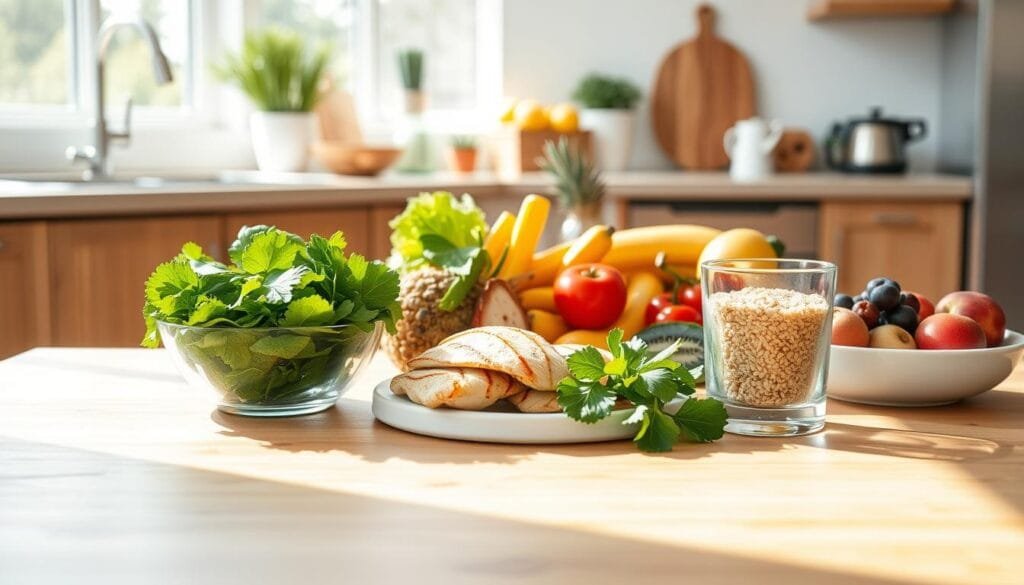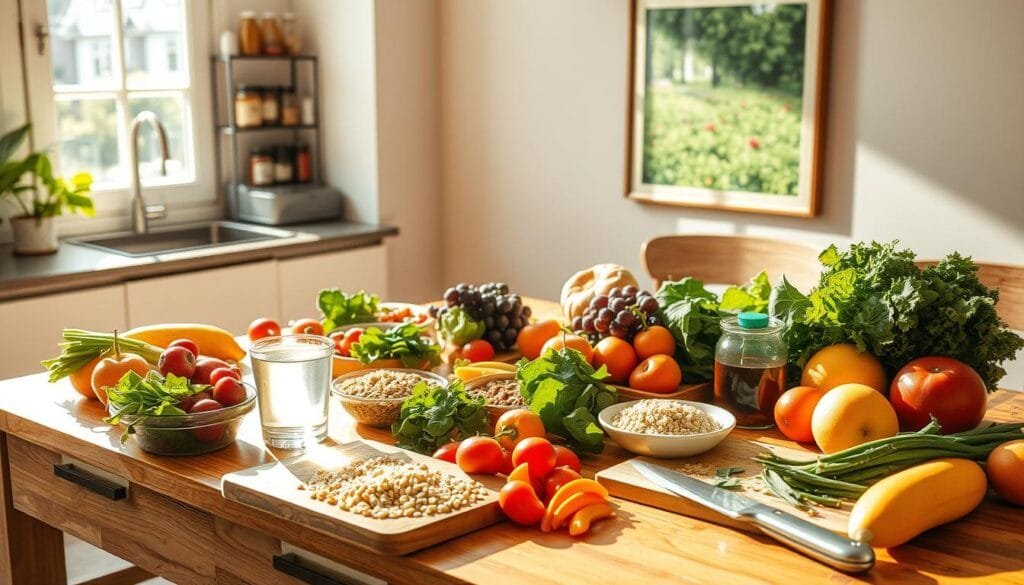Losing weight doesn’t have to be a struggle. You can learn how to make a diet plan for weight loss that works. Let’s explore strategies to help you shed extra pounds for good.
We’ll look at science-backed methods for fat loss. These aren’t quick fixes or fad diets. Instead, they’re proven ways to slim down.
A 1,500-calorie diet can help many people lose fat. Cutting 500 calories daily could help you lose a pound weekly. These tips can guide your weight loss journey.
We’ll cover calorie deficits and meal planning. Our goal is to help you make a diet plan for weight loss that’s tailored to your needs. Let’s start building a diet that really works for you.
Key Takeaways
- A balanced 1,500-calorie diet can be effective for fat loss
- Aim for a weight loss of 1-2 pounds per week for sustainable results
- Calorie needs vary based on gender, age, weight, height, and activity level
- High-fiber and high-protein diets promote fat loss
- Limiting processed foods and added sugars is crucial for weight loss
- Combining diet changes with regular physical activity enhances results
- Individualized approaches yield the best outcomes for weight loss
Understanding the Fundamentals of Weight Loss Science
Weight loss science can be tricky. But knowing the basics helps you succeed. Let’s look at key factors for fat loss and lasting results.
The Role of Caloric Deficit in Fat Loss
Caloric deficit is crucial for weight loss. It means burning more calories than you eat. To lose 1-2 pounds weekly, burn 500-750 calories more than you consume daily.
Metabolic Factors Affecting Weight Loss
Metabolic factors greatly impact weight loss. These include hormones, genetics, and body composition. Only 1-3% of people keep weight off long-term.
Knowing your unique metabolic factors is vital for success.
The Importance of Sustainable Weight Loss Rates
Sustainable weight loss is key to long-term success. Aim to lose 5% of your current weight. This can reduce health risks significantly.
For a 180-pound person, that’s 9 pounds. Mix diet changes with regular exercise for best results.
Research shows burning 2,000-3,000 calories weekly through exercise prevents weight regain.
| Weight Loss Strategy | Expected Results |
|---|---|
| Diet alone | Short-term weight loss |
| Exercise alone | 2-3 kg loss short-term |
| Diet + Exercise + Lifestyle changes | 7.2 kg loss after 6 months to 3 years |
Understanding these basics helps you create an effective weight loss plan. You can tailor it to your specific needs.
How to Make a Diet Plan for Weight Loss
Making a diet plan for weight loss requires understanding your calorie needs. You’ll need to set realistic goals and create a balanced meal schedule. Let’s explore these key components for an effective weight loss strategy.
Calculating Your Daily Caloric Needs
Start by figuring out your daily calorie needs. This varies based on age, gender, height, weight, and activity level. For weight loss, subtract 500-750 calories from your maintenance level.
Setting Realistic Weight Loss Goals
Aim for 1 to 2 pounds of weight loss per week. This approach helps you lose fat, not muscle. It also increases your chances of keeping the weight off long-term.
Creating a Balanced Meal Schedule
A balanced meal schedule is key for successful weight loss. The Mayo Clinic Healthy Weight Pyramid offers helpful guidelines. Fill your plate with various food groups.
- One-third to one-half non-starchy vegetables
- One-quarter to one-third protein-rich foods
- The remainder with whole grains, fruits, or starchy vegetables
This mix ensures you get needed nutrients while managing calories. It helps create a sustainable and healthy eating plan.
Tracking Progress and Making Adjustments
Regularly track your progress using food journals and weight trackers. Adjust your plan if you’re not seeing results. Flexibility is key to long-term success in your weight loss journey.
Essential Food Groups for Effective Weight Loss
A balanced diet is crucial for successful weight loss. Let’s explore the key food groups for your weight loss plan. These essentials will help you make smarter meal choices.
Lean Proteins and Their Impact on Satiety
Lean proteins are vital for weight loss. They keep you full longer and preserve muscle mass. A chicken breast has 27 grams of protein and under 150 calories.
Eggs for breakfast can help you eat less throughout the day. They’re better than a bagel for controlling hunger.
Complex Carbohydrates vs Simple Sugars
Complex carbs are your weight loss friends. They stabilize blood sugar and reduce cravings, unlike simple sugars. Oatmeal gives you 4 grams of fiber per cup.
A 5-inch baked sweet potato has 4 grams of fiber. It only contains 112 calories.

Healthy Fats and Their Role in Weight Loss
Don’t avoid healthy fats. They’re important for health and can help with weight loss. Walnuts add 2 grams of fiber per serving, plus protein.
Pistachios are low-calorie nuts. Fifty pistachios have about 160 calories.
Fiber-Rich Foods for Better Weight Management
Fiber-rich foods are key for weight control. They make you feel full and help digestion. A 2022 study showed high-fiber diets might reduce body fat.
Good fiber sources include chia seeds, whole grains, and cruciferous veggies. Legumes are also high in fiber.
| Food | Benefit | Nutritional Value |
|---|---|---|
| Chicken Breast | High protein, low calorie | 27g protein, under 150 calories |
| Oatmeal | Complex carb, high fiber | 4g fiber per cup |
| Sweet Potato | Complex carb, high fiber | 4g fiber, 112 calories (5-inch) |
| Pistachios | Healthy fat, low calorie nut | 160 calories per 50 nuts |
Developing Healthy Eating Habits and Behaviors
Healthy eating habits are crucial for successful weight loss. Our daily food choices greatly impact our health. Let’s explore strategies to improve eating habits for long-term weight management.

Mindful eating is key for weight control. It helps us recognize hunger cues and avoid overeating. Eat slowly, savor each bite, and listen to your body’s fullness signals.
Portion control is vital for healthy eating. Know proper serving sizes to manage calories without feeling deprived. Use smaller plates to make portions look bigger.
- Plan meals in advance to ensure a balanced diet
- Keep a food diary to track eating habits
- Eat slowly and mindfully to prevent overeating
- Use smaller plates for better portion control
- Aim for at least 5 portions of fruits and vegetables daily
Breaking bad habits takes time. Focus on small, consistent improvements instead of getting upset over slip-ups. Celebrate achievements like eating more veggies or choosing water over soda.
Good eating habits create a strong base for weight loss. They also improve your overall well-being. Start small and build these habits over time.
Strategic Meal Timing and Portion Control
Mastering meal timing and portions can boost your weight loss efforts. Let’s explore how these factors impact your health journey.
Optimal Meal Frequency for Weight Loss
The meal frequency debate continues. Some studies suggest eating smaller, more frequent meals can help control hunger.
This approach may work for some, while others prefer fewer, larger meals. Find what fits your lifestyle and hunger patterns best.
Understanding Portion Sizes
Portion control is key for managing calorie intake. Fill half your plate with veggies, a quarter with protein, and a quarter with carbs.
Aim for palm-sized protein portions and fist-sized carb servings. Using smaller plates can make you feel more satisfied with less food.
The Impact of Meal Timing on Metabolism
Meal timing affects weight management. Some studies show eating earlier in the day may benefit metabolism.
Intermittent fasting, which limits eating to specific times, has gained popularity. It works for some, but isn’t necessary for everyone.
The most important factor is keeping a consistent eating schedule. Focus on these meal planning aspects to optimize your diet.
Common Weight Loss Mistakes to Avoid
Weight loss can be tricky. Many people fall into traps that sabotage their efforts. Let’s explore some common mistakes and how to avoid them.
Extreme Calorie Restriction Pitfalls
Drastically cutting calories might seem like a quick fix. But it’s risky and can lead to muscle loss. It can also slow down your metabolism.
Instead, aim for a moderate calorie restriction. This allows for gradual, steady weight loss.
Check This:
- Weight Loss Made Simple: How to Track Your Macros for Weight Loss
- The Truth Revealed: Do Macro Diets Work for Weight Loss and Health?
Over-Reliance on Processed Diet Foods
Processed diet foods often promise quick results. But they can be counterproductive. Many low-fat options are loaded with sugar.
A 6-ounce serving can contain up to 23.5 grams of sugar! Choose whole, nutrient-dense foods instead.
Neglecting Proper Hydration
Staying hydrated is crucial for weight loss. Dehydration can slow down your metabolism and hinder progress. Don’t mistake thirst for hunger.
Drink water regularly throughout the day. This supports your body’s functions and weight loss efforts.
| Mistake | Impact | Better Approach |
|---|---|---|
| Extreme calorie restriction | Muscle loss, metabolic slowdown | Moderate calorie deficit |
| Reliance on processed diet foods | High sugar intake, nutrient deficiencies | Whole, nutrient-dense foods |
| Neglecting hydration | Slowed metabolism, increased hunger | Regular water intake throughout the day |
By avoiding these common pitfalls, you’ll set yourself up for success. Focus on making lasting lifestyle changes. This approach leads to sustainable weight loss.
Conclusion
Creating a personalized diet plan is key for sustainable weight loss. Understanding weight management science and strategic meal planning are crucial. Long-lasting lifestyle changes are more effective than quick-fix solutions.
Our guide covered caloric needs, balanced nutrition, and healthy eating habits. We highlighted portion control and meal timing. These elements form the backbone of an effective weight loss strategy.
Sustainable weight loss is a gradual process. The Mayo Clinic suggests changing your lifestyle for long-term success. Be patient with your progress and celebrate small victories.
Your journey to a healthier you is unique. Apply these principles consistently to achieve your ideal weight. Here’s to your health and well-being!
Source Links
- https://www.eatingwell.com/category/4305/weight-loss-meal-plans/ – Weight-Loss Meal Plans
- https://www.healthline.com/nutrition/1500-calorie-diet – A 1,500-Calorie Diet: Food Lists, Meal Plan and More

